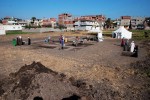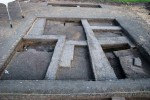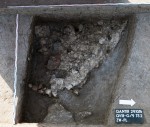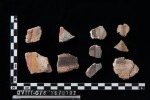 Archaeologists have discovered child-sized footprints in an ancient mortar pit at the archaeological site of Pi-Ramesse, modern-day Qantir, in Egypt. The site at the eastern edge of the Nile Delta about 70 miles northeast of Cairo was once the capital of the pharaoh Ramesses the Great (r. 1279–1213 B.C.) and is recorded in ancient sources as a city of great beauty, power and wealth. An estimated 300,000 people lived in the city which covered seven square miles during its heyday, making one of the biggest late Bronze Age cities in the Mediterranean both in area and population. It had a massive temple, riverside mansions, modest mud-brick homes, a planned street grid, a harbour, a system of navigable canals and lakes like Venice, Ramesses’ great palace, industrial works and high-end artisan workshops.
Archaeologists have discovered child-sized footprints in an ancient mortar pit at the archaeological site of Pi-Ramesse, modern-day Qantir, in Egypt. The site at the eastern edge of the Nile Delta about 70 miles northeast of Cairo was once the capital of the pharaoh Ramesses the Great (r. 1279–1213 B.C.) and is recorded in ancient sources as a city of great beauty, power and wealth. An estimated 300,000 people lived in the city which covered seven square miles during its heyday, making one of the biggest late Bronze Age cities in the Mediterranean both in area and population. It had a massive temple, riverside mansions, modest mud-brick homes, a planned street grid, a harbour, a system of navigable canals and lakes like Venice, Ramesses’ great palace, industrial works and high-end artisan workshops.
It was inhabited from the reign of Ramesses until and 1050 B.C. when the branch of the Nile that provided Pi-Ramesse with all of its water silted over. The pharaohs of the 21st Dynasty (1077-943 B.C.) used the former capital as a ready source of building materials. All the splendid architecture — temple reliefs, obelisks, statues, sphinxes — were moved whole to the new capital Tanis and reinstalled there. Entire buildings were dismantled in the abandoned city and rebuilt in the new capital. If the buildings weren’t worthy of reassembly at Tanis, they were simply demolished and their stone used for new structures. They were so thorough that nothing of Pi-Ramesse survives above the surface today.
 The site was discovered in the 1960s by Austrian Egyptologist Manfred Bietak. An international team of archaeologists based at the Roemer-Pelizaeus-Museum in Hildesheim, Germany, have excavated the site since 1980, discovering, among many other things, the largest bronze foundry ever discovered, glass-making workshops specializing in red glass, faience factories, a chariot manufacturer with massive stables that could accommodate close to 500 horses and a bone workshop that used the bones of animals long-since extinct in Egypt (lions, elephants, giraffes) that can only have been exotic imports in Ramesses’ days.
The site was discovered in the 1960s by Austrian Egyptologist Manfred Bietak. An international team of archaeologists based at the Roemer-Pelizaeus-Museum in Hildesheim, Germany, have excavated the site since 1980, discovering, among many other things, the largest bronze foundry ever discovered, glass-making workshops specializing in red glass, faience factories, a chariot manufacturer with massive stables that could accommodate close to 500 horses and a bone workshop that used the bones of animals long-since extinct in Egypt (lions, elephants, giraffes) that can only have been exotic imports in Ramesses’ days.
From 1996 through 2003, Caesium-Magnetometry was used to take measurements of the ancient city. The technology can differentiate between materials with different magnetic signatures, so for instance since mud brick responds differently than soil, mud-brick structures under the surface became apparent. With the magnetometry data, the team was able to map the layout of Pi-Ramesse.
 In one area they identified the remains of a monumental structure measuring about 820 by 490 feet and sections of walls. Archaeologists believe this was a construction site for the renovation of a monumental complex, likely a palace or a temple. Pottery sherds found on the spot date the building to between 1300 and 1200 B.C., so either during the reign of Ramesses or shortly thereafter. Near the monumental remains, the team found an intriguing feature this season: a mortar pit. The pit measures about eight by 26 feet and at the bottom an ancient layer of mortar was still extant. Embedded in the mortar were prints left by the pitter-patter of tiny feet.
In one area they identified the remains of a monumental structure measuring about 820 by 490 feet and sections of walls. Archaeologists believe this was a construction site for the renovation of a monumental complex, likely a palace or a temple. Pottery sherds found on the spot date the building to between 1300 and 1200 B.C., so either during the reign of Ramesses or shortly thereafter. Near the monumental remains, the team found an intriguing feature this season: a mortar pit. The pit measures about eight by 26 feet and at the bottom an ancient layer of mortar was still extant. Embedded in the mortar were prints left by the pitter-patter of tiny feet.
The footprints are 5.9-6.6 inches long, so about the size of kids between three and five years old, according to modern growth charts (which may or may not apply). Archaeologists can’t tell yet if they were left by multiple children or if the prints were smeared.
The reason for the children’s presence remains a mystery. Although no modern concept of banning child labor was in place, the footprints seem to be too small even for children who may have been working.
On the other hand, it appears unlikely that royal kids were left to play in the mud and mortar.
It does feel very satisfyingly squishy between your toes. I could easily see a little Prince demanding to have a stomp through the wet mortar, protocol be damned.
 On top of the mortar layer, the team found smashed piece of wall plaster bearing the remains of polychrome paint in black, yellow, red and shades of blue. The fragments are small and the original paintings appear to have been large-scale, so the team has not yet been able to identify imagery or motif from the pieces. The fragments are of hard plaster, a substance rarely used in Egyptian art, so may indicate foreign craftsmen were employed at the site. Fresco technique — pigment applied to wet plaster — is also extremely rare in ancient Egypt. More analysis is needed to determine whether this painted plaster was a fresco.
On top of the mortar layer, the team found smashed piece of wall plaster bearing the remains of polychrome paint in black, yellow, red and shades of blue. The fragments are small and the original paintings appear to have been large-scale, so the team has not yet been able to identify imagery or motif from the pieces. The fragments are of hard plaster, a substance rarely used in Egyptian art, so may indicate foreign craftsmen were employed at the site. Fresco technique — pigment applied to wet plaster — is also extremely rare in ancient Egypt. More analysis is needed to determine whether this painted plaster was a fresco.
Next season, archaeologists will excavate the pit further in the hope of recovering more missing pieces of the colored plaster. They will then try to puzzle them together to determine their motif and size, which will in turn suggest which walls the paintings may have once adorned. From what we know now, it was likely the monumental structure nearby. The mortar pit could have been used in the renovation and the frescoes stripped from the wall to redecorate in a style more au courant with the fashions 1200 B.C. They will also bring in specialists to analyze the footprints.